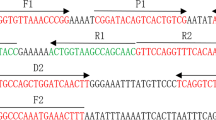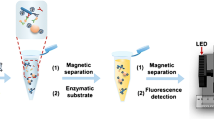Abstract
A disposable magnetogenosensor for the rapid, specific and sensitive detection of Streptococcus pneumoniae is reported. The developed procedure involves the use of streptavidin-modified magnetic beads, a specific biotinylated capture probe that hybridizes with a specific region of lytA, the gene encoding the pneumococcal major autolysin, and appropriate primers for asymmetric polymerase chain reaction (PCR) amplification. Capture probes and amplicons specific for S. pneumoniae were selected by a careful analysis of all lytA alleles available. The selected primers amplify a 235-bp fragment of pneumococcal lytA. A detection limit (LOD) of 5.1 nM was obtained for a 20-mer synthetic target DNA without any amplification protocol, while the LOD for the asymmetric PCR amplicon was 1.1 nM. A RSD value of 6.9% was obtained for measurements carried out with seven different genosensors for 1.1-nM aPCR product. The strict specificity of the designed primers was demonstrated by aPCR amplification of genomic DNA prepared from different bacteria, including some closely related streptococci. Direct asymmetric PCR (daPCR), using cells directly from broth cultures of S. pneumoniae, showed that daPCR products could be prepared with as few as 2 colony-forming units (CFU). Furthermore, this methodology did not show any cross-reaction with closely related streptococci such as Streptococcus mitis (or Streptococcus pseudopneumoniae) even when present in the culture at concentrations up to 105 times higher than that of S. pneumoniae. Preliminary data for rapid detection of pneumococcus directly in clinical samples has shown that it is possible to discriminate between non-inoculated blood and urine samples and samples inoculated with only 103 CFU mL−1 S. pneumoniae.

A lytA-based magnetogenosensor for pneumococcal identification: The lytA gene, encoding the main pneumococcal autolysin, is a suitable target for an accurate diagnosis of the pneumococcal disease. Asymmetric PCR amplification with precisely designed primers together with amperometric measurements allows a rapid and accurate differentiation between S. pneumoniae and closely related streptococci (see picture)




Similar content being viewed by others
References
WHO (2007) Wkly Epidemiol Rec 82:93–104
Lund E, Henrichsen J (1978) Methods Microbiol 12:241–262
Dowell SF, Garman RL, Liu G, Levine OS, Yang YH (2001) Clin Infect Dis 32:824–825
Samra Z, Shmuely H, Nahum E, Paghis D, Ben-Ari J (2003) Diagn Microbiol Infect Dis 45:237–240
Moore NJ, Fent MK, Koulchin VA, Molokova EV (2004) US Patent No. US 6,824,997 B1.
0Ehara N, Fukushima K, Kakeya H, Mukae H, Akamatsu S, Kageyama A, Saito A, Kohno S (2008) J Med Microbiol 57:820–826
Sheppard CL, Harrison TG, Morris R, Hogan A, George RC (2004) J Med Microbiol 53:189–195
Harris KA, Turner P, Green EA, Hartley JC (2008) J Clin Microbiol 46:2751–2758
Rouphael NG, Atwell-Melnick N, Longo D, Whaley M, Carlone GM, Sampson JS, Ades EW (2008) Diagn Microbiol Infect Dis 62:23–25
Smith MD, Sheppard CL, Hogan A, Harrison TG, Dance DAB, Derrington P, George RC, on behalf of the South West Pneumococcus Study Group (2009) J Clin Microbiol 47:1046–1049
Marriott HM, Mitchell TJ, Dockrell DH (2008) Curr Mol Med 8:497–509
García P, García JL, García E, López R (1986) Gene 43:265–272
López R, García E (2004) FEMS Microbiol Rev 28:553–580
Jefferies J, Nieminen L, Kirkham LA, Johnston C, Smith A, Mitchell TJ (2007) J Bacteriol 189:627–632
Simões AS, Sá-Leão R, Eleveld MJ, Tavares DA, Carriço JA, Bootsma HJ, Hermans PWM (2010) J Clin Microbiol 48:238–246
Obregón V, García P, García E, Fenoll A, López R, García JL (2002) J Clin Microbiol 40:2545–2554
Llull D, López R, García E (2006) J Clin Microbiol 44:1250–1256
Lucarelli F, Tombelli S, Minunni M, Marrazza G, Mascini M (2008) Anal Chim Acta 609:139–159
Drummond TG, Hill MG, Barton JK (2003) Nat Biotechnol 21:1192–1199
Liao JC, Mastali M, Gau V, Suchard MA, Møller AK, Bruckner DA, Babbitt JT, Li Y, Gornbein J, Landaw EM, McCabe ERB, Churchill BM, Haake DA (2006) J Clin Microbiol 44:61–570
Mastali M, Babbitt JT, Li Y, Landaw EM, Gau V, Churchill BM, Haake DA (2008) J Clin Microbiol 46:2707–2716
Paleček E, Fojta M (2007) Talanta 74:276–290
Fuentes M, Mateo C, Rodriguez A, Casqueiro M, Tercero JC, Riese HH, Fernández-Lafuente R, Guisán JM (2006) Biosens Bioelectron 21:1574–1580
Wang J, Flechsig GU, Erdem A, Korbut O, Gründler P (2004) Electroanal 16:928–931
Morales M, García P, de la Campa AG, Liñares J, Ardanuy C, García E (2010) J Bacteriol 192:2624–2632
Lacks S, Hotchkiss RD (1960) Biochim Biophys Acta 39:508–517
Loaiza ÓA, Campuzano S, Pedrero M, Pividori MI, García P, Pingarrón JM (2008) Anal Chem 80:8239–8245
Campuzano S, Pedrero M, Pingarrón JM (2005) Talanta 66:1310–1319
Long GL, Winefordner JD (1983) Anal Chem 55:712A–724A
Hasebe K, Osteryoung J (1975) Anal Chem 47:2412–2418
Hernández-Santos D, González-García MB, Costa-García A (2005) Anal Chem 77:2868–2874
Xu D, Huang K, Liu Z, Liu Y, Ma L (2001) Electroanal 13:882–887
Carpini G, Lucarelli F, Marrazza G, Mascini M (2004) Biosens Bioelectron 20:167–175
Del Giallo ML, Ariksoysal DO, Marrazza G, Mascini M, Ozsoz M (2005) Anal Lett 38:2509–2523
Tang L, Zeng G, Shen G, Li Y, Liu C, Li Z, Luo J, Fan C, Yang C (2009) Biosens Bioelectron 24:1474–1479
Hernández-Santos D, Díaz-González M, González-García MB, Costa-García A (2004) Anal Chem 76:6887–6893
Fode-Vaughan KA, Wimpee CF, Remsen CC, Collins MLP (2001) Biotechniques 31:598–607
Acknowledgments
This research was supported by a grant from the Dirección General de Investigación Científica y Técnica (SAF2009-10824). CIBER de Enfermedades Respiratorias (CIBERES) is an initiative of Spanish Instituto de Salud Carlos III. The financial support of Santander/Complutense Research Project PR 27/05-13953, and of the Spanish Ministerio de Ciencia e Innovación Research Project CTQ2009-09351BQU, and the AVANSENS Program from the Comunidad de Madrid (S2009PPQ-1642) are also gratefully acknowledged. S.C. acknowledges a “Juan de la Cierva” research contract.
Author information
Authors and Affiliations
Corresponding author
Electronic supplementary material
Below is the link to the electronic supplementary material.
ESM 1
(PDF 87 kb)
Rights and permissions
About this article
Cite this article
Campuzano, S., Pedrero, M., García, J.L. et al. Development of amperometric magnetogenosensors coupled to asymmetric PCR for the specific detection of Streptococcus pneumoniae . Anal Bioanal Chem 399, 2413–2420 (2011). https://doi.org/10.1007/s00216-010-4645-0
Received:
Revised:
Accepted:
Published:
Issue Date:
DOI: https://doi.org/10.1007/s00216-010-4645-0




